Effect of Simplified Bonding on Shear Bond Strength between Ceramic Brackets and Dental Zirconia
Abstract
1. Introduction
2. Materials and Methods
2.1. Preparation of Y-TZP
2.2. Observation of Surface Charateristics of Y-TZP
2.2.1. Examination by Field Emission-Scanning Electron Microscope
2.2.2. Measurement of Surface Roughness
2.2.3. Measurement of Contact Angle
2.3. Bonding of Bracket and Shear Bond Strength Test
2.3.1. Experimental Design and Bonding the Bracket to Y-TZP
2.3.2. Shear Bond Strength Test
3. Results
3.1. Surface Characteristics of Y-TZP
3.1.1. Field Emission-Scanning Electron Microscopic Examination
3.1.2. Measurement of Surface Roughness
3.1.3. Measurement of Contact Angle
3.2. Shear Bond Strength and Failure Mode
4. Discussion
5. Conclusions
Author Contributions
Funding
Conflicts of Interest
References
- Heintze, S.D.; Rousson, V. Survival of zirconia- and metal-supported fixed dental prostheses: A systematic review. Int. J. Prosthodont. 2010, 23, 493–502. [Google Scholar] [PubMed]
- Meyenberg, K.H.; Lüthy, H.; Schärer, P. Zirconia posts: A new all-ceramic concept for nonvital abutment teeth. J. Esthet. Restor. Dent. 1995, 7, 73–80. [Google Scholar] [CrossRef]
- Al-Amleh, B.; Lyons, K.; Swain, M. Clinical trials in zirconia: A systematic review. J. Oral Rehabil. 2010, 37, 641–652. [Google Scholar] [CrossRef] [PubMed]
- Piconi, C.; Maccauro, G. Zirconia as a ceramic biomaterial. Biomaterials 1999, 20, 1–25. [Google Scholar] [CrossRef]
- Magne, P.; Paranhos, M.P.; Burnett, L.H., Jr. New zirconia primer improves bond strength of resin-based cements. Dent. Mater. 2010, 26, 345–352. [Google Scholar] [CrossRef]
- Denry, I.; Kelly, J.R. State of the art of zirconia for dental applications. Dent. Mater. 2008, 24, 299–307. [Google Scholar] [CrossRef]
- Kelly, J.R. Ceramics in restorative and prosthetic dentistry. Annu. Rev. Mater. Sci. 1997, 27, 443–468. [Google Scholar] [CrossRef]
- Nettleship, I.; Stevens, R. Tetragonal zirconia polycrystal (TZP)—A review. Int. J. High Technol. Ceram. 1987, 3, 1–32. [Google Scholar] [CrossRef]
- Giordano, R. Materials for chairside CAD/CAM–produced restorations. J. Am. Dent. Assoc. 2006, 137, 14S–21S. [Google Scholar] [CrossRef]
- Beuer, F.; Stimmelmayr, M.; Gueth, J.-F.; Edelhoff, D.; Naumann, M. In vitro performance of full-contour zirconia single crowns. Dent. Mater. 2012, 28, 449–456. [Google Scholar] [CrossRef]
- Bavbek, N.C.; Roulet, J.F.; Ozcan, M. Evaluation of microshear bond strength of orthodontic resin cement to monolithic zirconium oxide as a function of surface conditioning method. J. Adhes. Dent. 2014, 16, 473–480. [Google Scholar]
- Pabari, S.; Moles, D.R.; Cunningham, S.J. Assessment of motivation and psychological characteristics of adult orthodontic patients. Am. J. Orthod. Dentofacial Orthop. 2011, 140, e263–e272. [Google Scholar] [CrossRef]
- Reddy, M.R.; Revathi, P.; Naveen, K.; Reddy, S.R.K. Esthetic orthodontic brackets: A comprehensive review. J. Orofac. Sci. 2010, 2, 42–50. [Google Scholar]
- Yi, Y.A.; Ahn, J.S.; Park, Y.J.; Jun, S.H.; Lee, I.B.; Cho, B.H.; Son, H.-H.; Seo, D.-G. The effect of sandblasting and different primers on shear bond strength between yttria-tetragonal zirconia polycrystal ceramic and a self-adhesive resin cement. Oper. Dent. 2015, 40, 63–71. [Google Scholar] [CrossRef] [PubMed]
- Ozcan, M.; Nijhuis, H.; Valandro, L.F. Effect of various surface conditioning methods on the adhesion of dual-cure resin cement with MDP functional monomer to zirconia after thermal aging. Dent. Mater. J. 2008, 27, 99–104. [Google Scholar] [CrossRef] [PubMed]
- Tanaka, R.; Fujishima, A.; Shibata, Y.; Manabe, A.; Miyazaki, T. Cooperation of phosphate monomer and silica modification on zirconia. J. Dent. Res. 2008, 87, 666–670. [Google Scholar] [CrossRef] [PubMed]
- Cavalcanti, A.N.; Oliveira, M.T.; Gianinni, M.; Marchi, G.M.; Pilecki, P.; Watson, T.F.; Oliveira, M.T.; Gianinni, M.; Marchi, G.M. Evaluation of the surface roughness and morphologic features of Y-TZP ceramics after different surface treatments. Photomed. Laser Surg. 2009, 27, 473–479. [Google Scholar] [CrossRef]
- Maeda, F.A.; Bello-Silva, M.S.; de Paula, E.C.; Miranda, W.G., Jr.; Cesar, P.F. Association of different primers and resin cements for adhesive bonding to zirconia ceramics. J. Adhes. Dent. 2014, 16, 261–265. [Google Scholar]
- Piascik, J.R.; Swift, E.J.; Thompson, J.Y.; Grego, S.; Stoner, B.R. Surface modification for enhanced silanation of zirconia ceramics. Dent. Mater. 2009, 25, 1116–1121. [Google Scholar] [CrossRef]
- Piascik, J.R.; Wolter, S.D.; Stoner, B.R. Development of a novel surface modification for improved bonding to zirconia. Dent. Mater. 2011, 27, e99–e105. [Google Scholar] [CrossRef]
- Yang, B.; Barloi, A.; Kern, M. Influence of air-abrasion on zirconia ceramic bonding using an adhesive composite resin. Dent. Mater. 2010, 26, 44–50. [Google Scholar] [CrossRef]
- Tsuo, Y.; Yoshida, K.; Atsuta, M. Effects of alumina-blasting and adhesive primers on bonding between resin luting agent and zirconia ceramics. Dent. Mater. J. 2006, 25, 669–674. [Google Scholar] [CrossRef]
- Carreira, M.; Antunes, P.V.; Ramalho, A.; Paula, A.; Carrilho, E. Thermocycling effect on mechanical and tribological characterization of two indirect dental restorative materials. J. Braz. Soc. Mech. Sci. Eng. 2017, 39, 1–17. [Google Scholar] [CrossRef]
- Yang, B.; Wolfart, S.; Scharnberg, M.; Ludwig, K.; Adelung, R.; Kern, M. Influence of contamination on zirconia ceramic bonding. J. Dent. Res. 2007, 86, 749–753. [Google Scholar] [CrossRef]
- ISO/TS 11405:2015. Dental Materials-Testing of Adhesion to Tooth Structure; International Organization for Standardization: Geneva, Switzerland, 2015.
- Morresi, A.L.; D’Amario, M.; Capogreco, M.; Gatto, R.; Marzo, G.; D’Arcangelo, C.; Monaco, A. Thermal cycling for restorative materials: does a standardized protocol exist in laboratory testing? A literature review. J. Mech. Behav. Biomed. Mater. 2014, 2, 295–308. [Google Scholar] [CrossRef] [PubMed]
- Gale, M.; Darvell, B.W. Thermal cycling procedures for laboratory testing of dental restorations. J. Dent. 1999, 27, 89–99. [Google Scholar] [CrossRef]
- Miyazaki, T.; Nakamura, T.; Matsumura, H.; Ban, S.; Kobayashi, T. Current status of zirconia restoration. J. Prosthodont. 2013, 5, 236–261. [Google Scholar] [CrossRef]
- Zhang, Y.; Lawn, B.R.; Rekow, E.D.; Thompson, V.P. Effect of sandblasting on the long-term performance of dental ceramics. J. Biomed. Mater. Res. B Appl. Biomater. 2004, 71, 381–386. [Google Scholar] [CrossRef]
- Kosmač, T.; Oblak, C.; Jevnikar, P.; Funduk, N.; Marion, L. The effect of surface grinding and sandblasting on flexural strength and reliability of Y-TZP zirconia ceramic. Dent. Mater. 1999, 15, 426–433. [Google Scholar] [CrossRef]
- Curtis, A.R.; Wright, A.J.; Fleming, G.J. The influence of surface modification techniques on the performance of a Y-TZP dental ceramic. J. Dent. 2006, 34, 195–206. [Google Scholar] [CrossRef]
- Karakoca, S.; Yilmaz, H. Influence of surface treatments on surface roughness, phase transformation and biaxial flexural strength of Y-TZP ceramics. J. Biomed. Mater. Res. B Appl. Biomater. 2009, 91, 930–937. [Google Scholar] [CrossRef]
- Demir, N.; Subaşi, M.G.; Ozturk, A.N. Surface roughness and morphologic changes of zirconia following different surface treatments. Photomed. Laser Surg. 2012, 30, 339–345. [Google Scholar] [CrossRef]
- Qeblawi, D.M.; Muñoz, C.A.; Brewer, J.D.; Monaco, E.A., Jr. The effect of zirconia surface treatment on flexural strength and shear bond strength to a resin cement. J. Prosthet. Dent. 2010, 103, 210–220. [Google Scholar] [CrossRef]
- Kim, N.-H.; Kim, Y.-J.; Lee, D.-Y. Bond strengths of orthodontic metal brackets to tribochemically silica-coated zirconia surfaces using different 10-methacryloyloxydecyl dihydrogen phosphate-containing primers. J. Adhes. Dent. 2017, 19, 21–29. [Google Scholar] [CrossRef] [PubMed]
- Kern, M.; Barloi, A.; Yang, B. Surface conditioning influences zirconia ceramic bonding. J. Dent. Res. 2009, 88, 817–822. [Google Scholar] [CrossRef]
- Da Silva, E.M.; Miragaya, L.; Sabrosa, C.E.; Maia, L.C. Stability of the bond between two resin cements and an yttria-stabilized zirconia ceramic after six months of aging in water. J. Prosthet. Dent. 2014, 112, 568–575. [Google Scholar] [CrossRef]
- Matinlinna, J.P.; Heikkinen, T.; Özcan, M.; Lassila, L.V.J.; Vallittu, P.K. Evaluation of resin adhesion to zirconia ceramic using some organosilanes. Dent. Mater. 2006, 22, 824–831. [Google Scholar] [CrossRef]
- Attia, A. Bond strength of three luting agents to zirconia ceramic-influence of surface treatment and thermocycling. J. Appl. Oral Sci. 2011, 19, 388–395. [Google Scholar] [CrossRef]
- Reynolds, I.R. A review of direct orthodontic bonding. Br. J. Orthod. 1975, 2, 171–178. [Google Scholar] [CrossRef]
- Ito, S.; Hoshino, T.; Iijima, M.; Tsukamoto, N.; Pashley, D.H.; Saito, T. Water sorption/solubility of self-etching dentin bonding agents. Dent. Mater. 2010, 26, 617–626. [Google Scholar] [CrossRef]
- Giannini, M.; Makishi, P.; Ayres, A.P.A.; Vermelho, P.M.; Fronza, B.M.; Nikaido, T.; Tagami, J. Self-etch adhesive systems: A literature review. Braz. Dent. J. 2015, 26, 3–10. [Google Scholar] [CrossRef] [PubMed]
- Lee, J.-Y.; Ahn, J.; An, S.I.; Park, J.-W. Comparison of bond strengths of ceramic brackets bonded to zirconia surfaces using different zirconia primers and a universal adhesive. Restor. Dent. Endod. 2018, 43, e7. [Google Scholar] [CrossRef] [PubMed]
- Amaral, M.; Belli, R.; Cesar, P.F.; Valandro, L.F.; Petschelt, A.; Lohbauer, U. The potential of novel primers and universal adhesives to bond to zirconia. J. Dent. 2014, 42, 90–98. [Google Scholar] [CrossRef] [PubMed]
- Montasser, M.A.; Drummond, J.L. Reliability of the adhesive remnant index score system with different magnifications. Angle Orthod. 2009, 79, 773–776. [Google Scholar] [CrossRef] [PubMed]
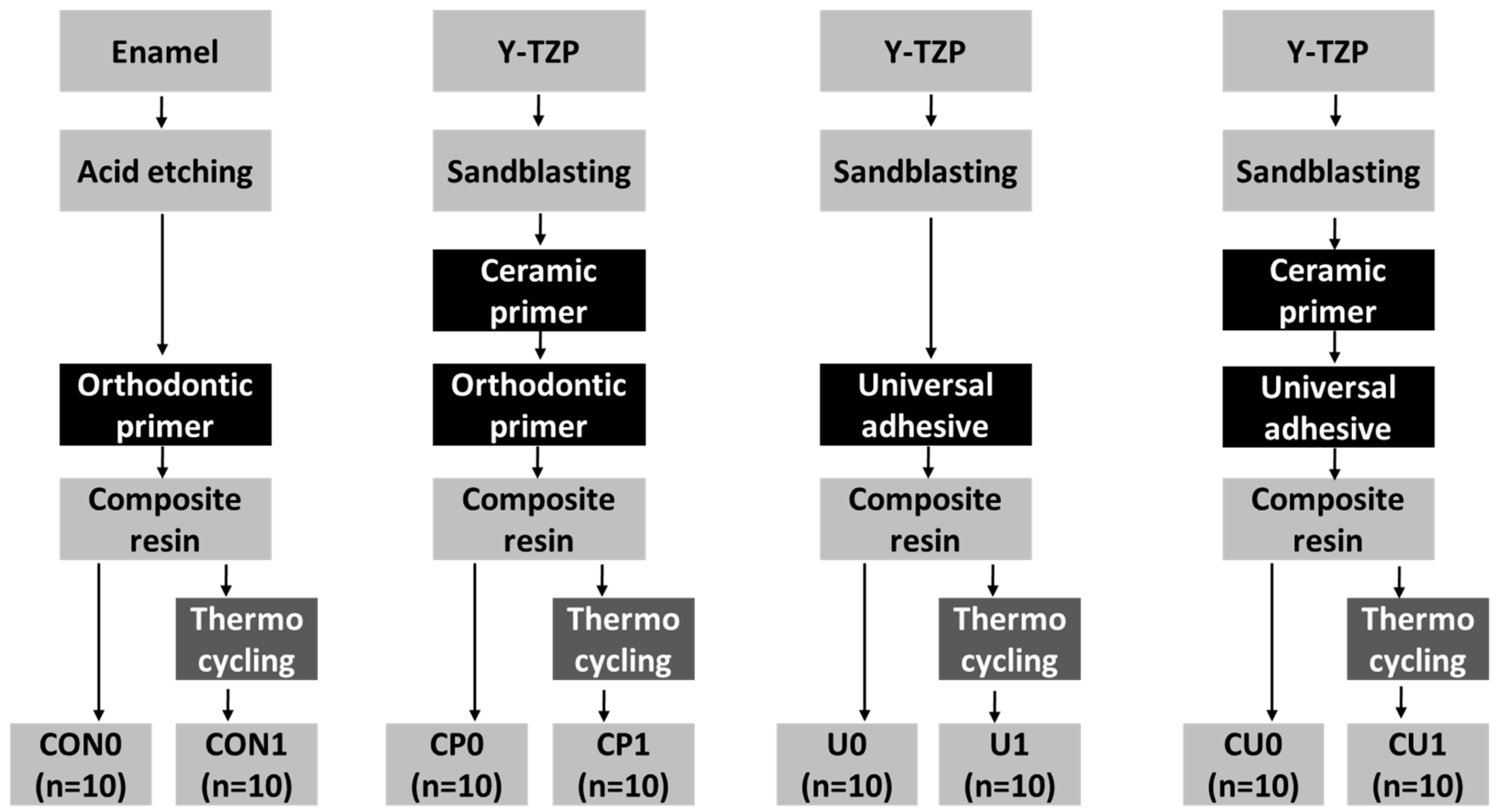
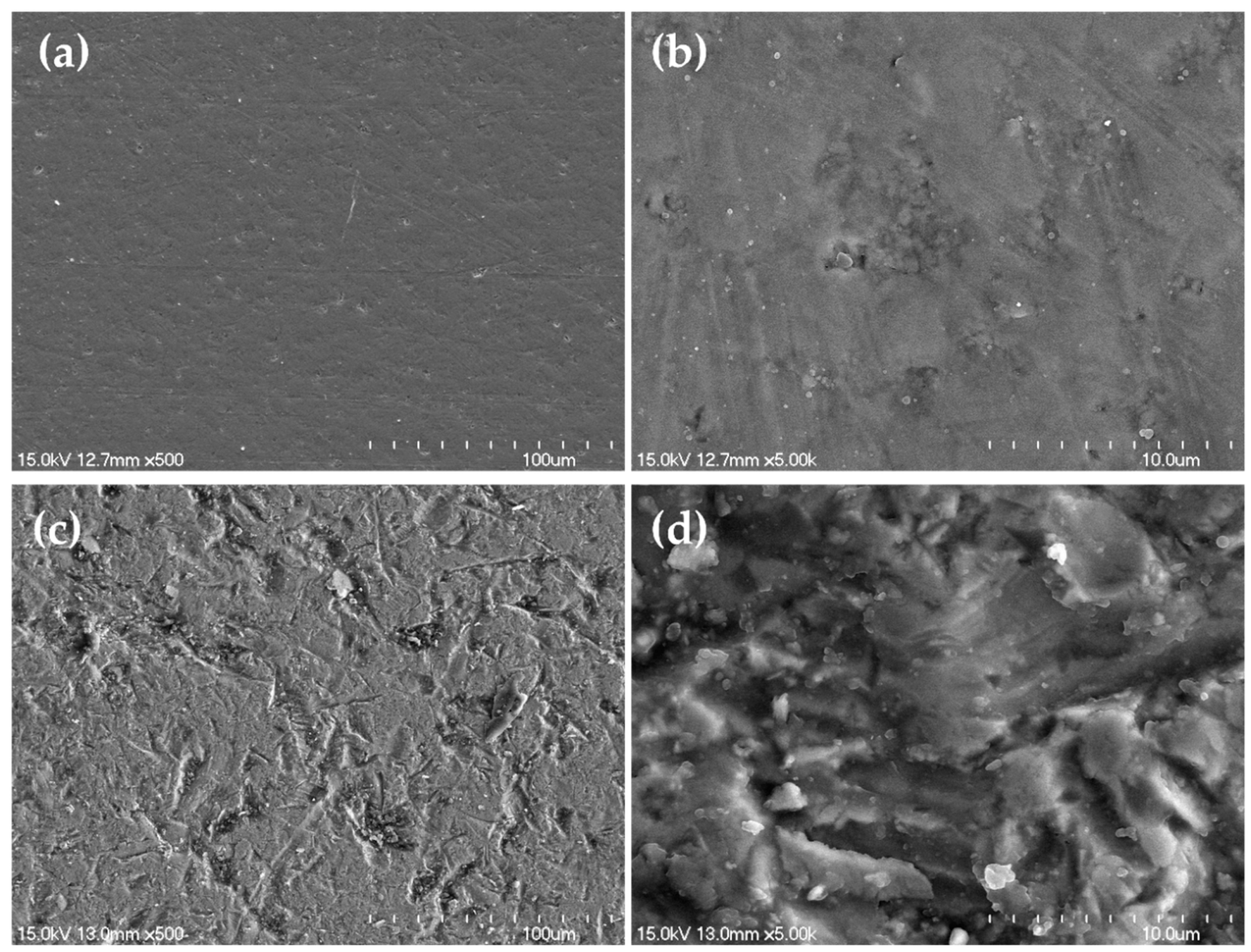
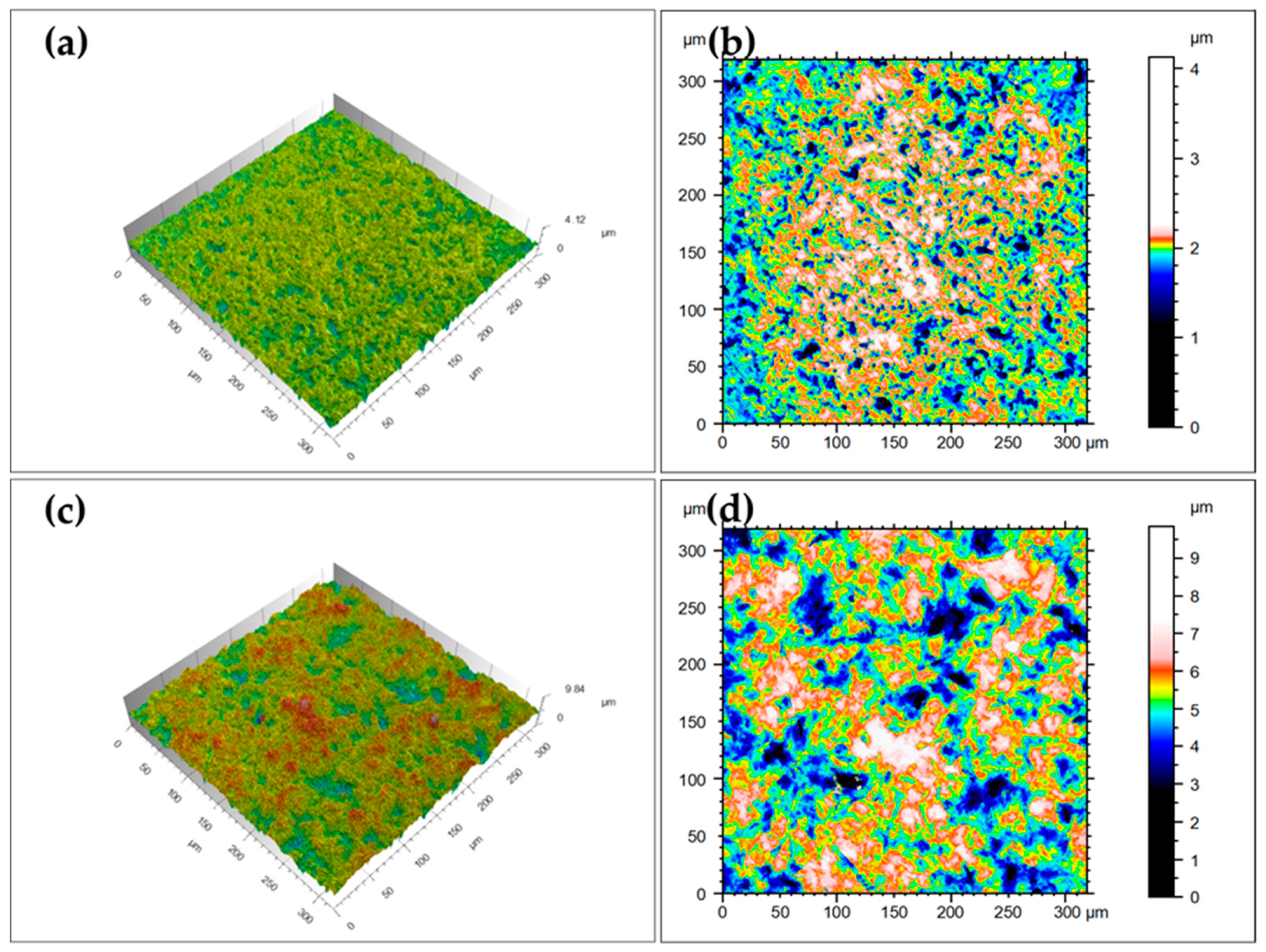
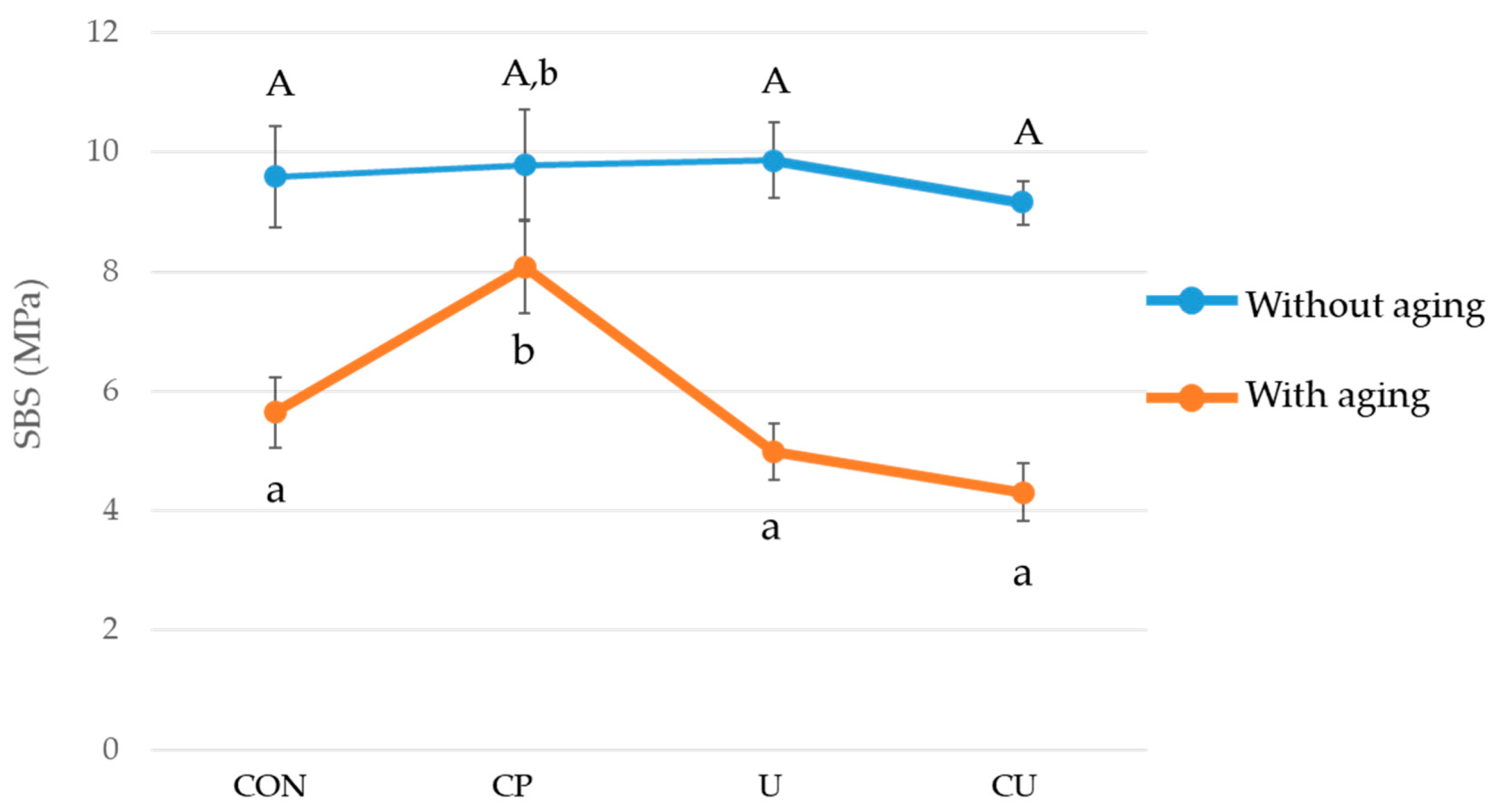
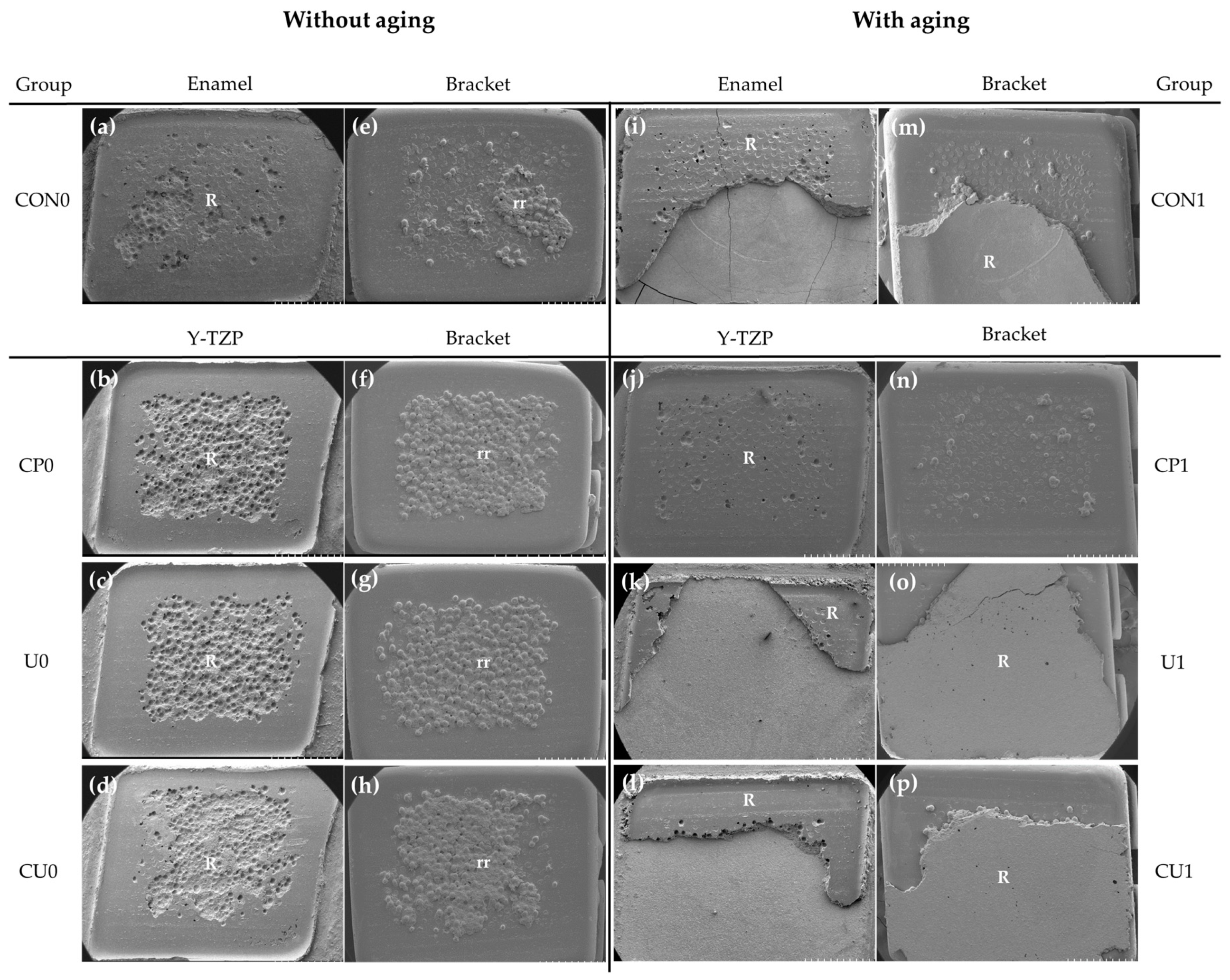
| Material | Product Name | LOT Number | Main Component | Manufacturer |
|---|---|---|---|---|
| Zirconia | LAVA Plus | 515920 | Tetragonal polycrystalline zirconia, 3 mol% yttria, alumina | 3M ESPE, USA |
| Primer | Clearfil ceramic primer | 240010 | 3-Methacryloxypropyl trimethoxy silane, a 10-MDP, ethanol | Kuraray, Japan |
| Adhesive | Transbond XT adhesive primer | ER7BS | b TEGDMA, c bis-GMA, triphenylantimony, 4-(dimethylamino)-benzeneethanol, dl-camphorquinone, hydroquinone | 3M Unitek, USA |
| Clearfil S3 Bond | 170008 | 10-MDP a, c bis-GMA, d HEMA, hydrophobic demethacrylate, dl-camphorquinone, ethyl alcohol, water, silanated colloidal silica | Kuraray, Japan | |
| Composite Resin | Transbond XT adhesive paste | ER7BS | Silane treated quartz, c bis-GMA, bisphenol A bis (2-hydroxyethyl ether) dimethacrylate, silane-treated silica | 3M Unitek, USA |
| Etchant | Scotchbond Universal Etchant | 577060 | Water, phosphoric acid, synthetic amorphous silica, fumed, polyethylene glycol, aluminium oxide | 3M ESPE, USA |
| ARI Score | Criterion |
|---|---|
| 0 | No adhesive left on the tooth |
| 1 | Less than half of the adhesive left on the tooth |
| 2 | More than half of the adhesive left on the tooth |
| 3 | All adhesive left on the tooth, with a distinct impression of the bracket mesh |
| 4 | Enamel fracture |
| Group | Shear Bond Strength (MPa) | Group | Shear Bond Strength (MPa) |
|---|---|---|---|
| CON0 | 9.59 ± 1.77 (8.32–10.86) | CON1 | 5.65 ± 1.24 (4.76–6.54) |
| CP0 | 9.78 ± 1.94 (8.40–11.18) | CP1 | 8.16 ± 1.78 (6.88–9.43) |
| U0 | 9.86 ± 1.33 (8.90–10.81) | U1 | 4.99 ± 0.99 (4.28–5.70) |
| CU0 | 9.16 ± 0.78 (8.60–9.71) | CU1 | 4.31 ± 1.02 (3.58–5.03) |
| Without Aging | ARI Score | With Aging | ARI Score | ||||||
|---|---|---|---|---|---|---|---|---|---|
| 0 | 1 | 2 | 3 | 0 | 1 | 2 | 3 | ||
| CON0 | – | 20 | – | 80 | CON1 | 10 | 20 | 10 | 60 |
| CP0 | – | – | – | 100 | CP1 | – | – | – | 100 |
| U0 | – | – | – | 100 | U1 | – | 40 | – | 60 |
| CU0 | – | – | – | 100 | CU1 | – | 40 | – | 60 |
© 2019 by the authors. Licensee MDPI, Basel, Switzerland. This article is an open access article distributed under the terms and conditions of the Creative Commons Attribution (CC BY) license (http://creativecommons.org/licenses/by/4.0/).
Share and Cite
Ju, G.-Y.; Oh, S.; Lim, B.-S.; Lee, H.-S.; Chung, S.H. Effect of Simplified Bonding on Shear Bond Strength between Ceramic Brackets and Dental Zirconia. Materials 2019, 12, 1640. https://doi.org/10.3390/ma12101640
Ju G-Y, Oh S, Lim B-S, Lee H-S, Chung SH. Effect of Simplified Bonding on Shear Bond Strength between Ceramic Brackets and Dental Zirconia. Materials. 2019; 12(10):1640. https://doi.org/10.3390/ma12101640
Chicago/Turabian StyleJu, Ga-Youn, Soram Oh, Bum-Soon Lim, Hyun-Seung Lee, and Shin Hye Chung. 2019. "Effect of Simplified Bonding on Shear Bond Strength between Ceramic Brackets and Dental Zirconia" Materials 12, no. 10: 1640. https://doi.org/10.3390/ma12101640
APA StyleJu, G.-Y., Oh, S., Lim, B.-S., Lee, H.-S., & Chung, S. H. (2019). Effect of Simplified Bonding on Shear Bond Strength between Ceramic Brackets and Dental Zirconia. Materials, 12(10), 1640. https://doi.org/10.3390/ma12101640





